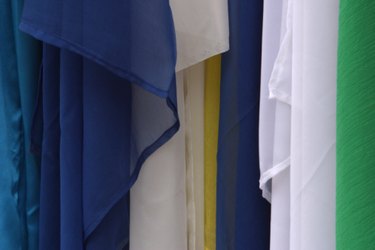Things You'll Need
Unfinished sheer fabric garment or curtains
Ruler or quilter's square
Sharp scissors or rotary fabric cutter
Hand sewing needle, size 11 or 12
Light-weight cotton thread
Pattern-making or white wrapping tissue paper
Thin sewing pins
Sewing machine
Sewing machine needle, size 8 or 9
Needle-nosed tweezers
Iron
Ironing board

Lightweight sheer fabrics such as crepe, batiste, chiffon or voile are used for creating delicate curtains, blouses, wedding veils and gown overlays. However, the attributes that make such fabrics so attractive can also make them intimidating to tackle. The soft, silky textures and open weave of sheer fabrics make them slippery and hard to control, and they tend to fray easily. Puckering can be prevented by using sewing needles sized for stitching fine fabrics. Two common hem styles for sheer fabrics are the hand-rolled hem and the machine-stitched hem.
Hand-Rolled Hem
Step 1
Trim the unfinished edge of the fabric evenly with very sharp scissors or a rotary fabric cutter using a ruler or quilter's square as a guide.
Video of the Day
Step 2
Stitch a line completely around or across the fabric about 1/8 inch from the raw edge. Trim the edge again almost to the stitching, leaving no more than 1/16 inch of fabric free.
Step 3
Thread a hand-sewing needle with lightweight cotton thread. Begin rolling the fabric edge over the stitched line with a thumb and forefinger at a seam or a vertical edge.
Step 4
Insert the needle through the middle of the roll and catch a single thread of fabric next to the raw edge. Bring the needle back and take a 1/8- to 1/4-inch stitch in the fold.
Step 5
Continue stitching until 1 to 2 inches of hem is stitched. Gently pull on the thread to tighten the stitches. Repeat this procedure until the hem is complete. This will help roll the fabric and hide the stitching.
Machine-Stitched Hem
Step 1
Trim the raw edge of the fabric evenly using sharp scissors or a rotary fabric cutter. Cut enough 1-inch-wide strips of tissue paper to match the length or circumference of the fabric and pin the strips end-to-end along the raw edge on the wrong side of the fabric.
Step 2
Stitch the tissue paper to the fabric about 1/4 inch inside the raw edges using a 12- to 15-stitch-per-inch setting on the sewing machine.
Step 3
Gently tear off the tissue paper along the stitch line, removing any small pieces with needle-nosed tweezers. This tissue paper will be perforated by the sewing machine needle.
Step 4
Fold the fabric over along the stitching line, then adjust and pin the fold to the fabric. Stitch a hem about 1/4 inch in from the inner edge. Trim all the thread ends. Press the hem lightly with an iron on a low, dry setting.
Step 5
Make one more fold along the inner hem edge and pin it to the fabric. Stitch the final hem about 1/8-inch along the inner edge. Do not backstitch at the end of the hem; secure it by hand with two to three small stitches. Press the finished piece along the hem with an iron set on low.
Tip
To avoid fabric slipping, stick a small piece of masking tape across the sewing machine's throat plate.
Warning
Backstitching will pucker the material, so use the smallest stitch setting at the beginning and end of each hem.
Video of the Day